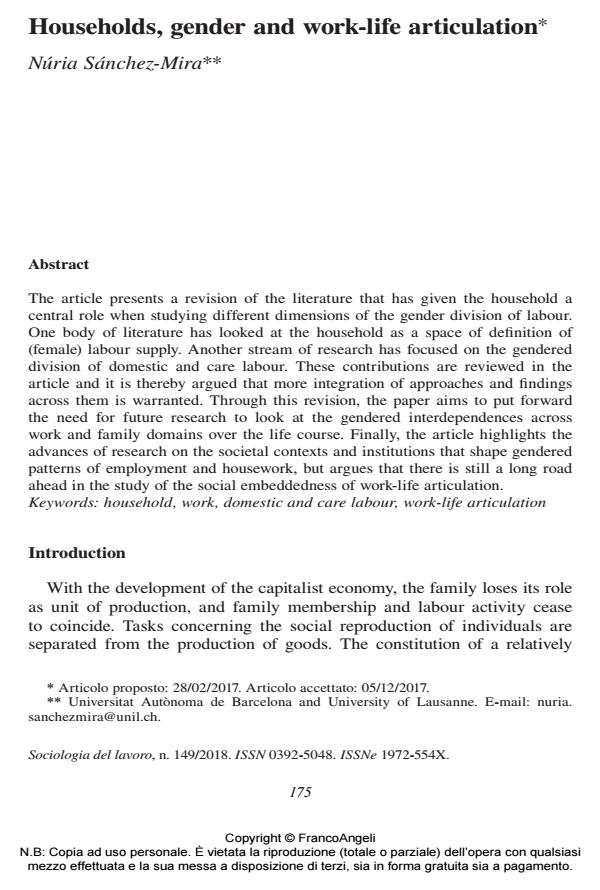Households, gender and work-life articulation
Titolo Rivista SOCIOLOGIA DEL LAVORO
Autori/Curatori Núria Sánchez-Mira
Anno di pubblicazione 2018 Fascicolo 2018/149
Lingua Inglese Numero pagine 15 P. 175-189 Dimensione file 131 KB
DOI 10.3280/SL2018-149011
Il DOI è il codice a barre della proprietà intellettuale: per saperne di più
clicca qui
Qui sotto puoi vedere in anteprima la prima pagina di questo articolo.
Se questo articolo ti interessa, lo puoi acquistare (e scaricare in formato pdf) seguendo le facili indicazioni per acquistare il download credit. Acquista Download Credits per scaricare questo Articolo in formato PDF

FrancoAngeli è membro della Publishers International Linking Association, Inc (PILA)associazione indipendente e non profit per facilitare (attraverso i servizi tecnologici implementati da CrossRef.org) l’accesso degli studiosi ai contenuti digitali nelle pubblicazioni professionali e scientifiche
The article presents a revision of the literature that has given the household a central role when studying different dimensions of the gender division of labour. One body of literature has looked at the household as a space of definition of (female) labour supply. Another stream of research has focused on the gendered division of domestic and care labour. These contributions are reviewed in the article and it is thereby argued that more integration of approaches and findings across them is warranted. Through this revision, the paper aims to put forward the need for future research to look at the gendered interdependences across work and family domains over the life course. Finally, the article highlights the advances of research on the societal contexts and institutions that shape gendered patterns of employment and housework, but argues that there is still a long road ahead in the study of the social embeddedness of work-life articulation.
L’articolo presenta una revisione della letteratura che ha attribuito alla famiglia un ruolo centrale nello studio delle diverse dimensioni della divisione del lavoro di genere. Un corpus di letteratura ha considerato la famiglia come un ambito di defi-nizione dell'offerta di lavoro (femminile). Un altro filone di ricerca si è concentrato sulla divisione di genere del lavoro domestico e di cura. Questi contributi vengono esaminati nell'articolo e si giunge a sostenere la necessità di una maggiore integrazione tra gli approcci e relativi risultati ai approdano. Attraverso tale revisione della letteratura, l’articolo mira a far avanzare la ricerca sulla disamina delle interdipendenze tra i generi negli ambiti lavorativo e domestico, nel corso della vita. Infi-ne, l'articolo mette in evidenza i progressi della ricerca sulle istituzioni sociali che contribuiscono a definire i modelli di divisione del lavoro nel mercato e nella fa-miglia, ma sostiene che vi è ancora una lunga strada da percorrere nello studio di soluzioni inclusive alla problematica della conciliazione famiglia e lavoro.
Parole chiave:Famiglia, lavoro, lavoro domestico e di cura, conciliazione famiglia-lavoro
- The value of parenting: gendered time expectations among the Spanish middle class Dafne Muntanyola-Saura, Núria Sánchez-Mira, in Visual Studies /2023 pp.442
DOI: 10.1080/1472586X.2021.1940264
Núria Sánchez-Mira, Households, gender and work-life articulation in "SOCIOLOGIA DEL LAVORO " 149/2018, pp 175-189, DOI: 10.3280/SL2018-149011